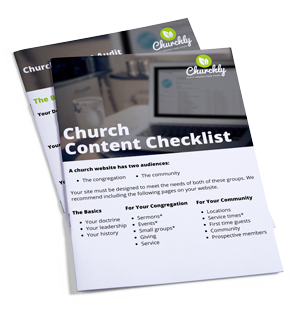4 Things Visitors Look for on Your Church Website
Content Rob LaughterWith the use of technology today, people can easily navigate hundreds of churches in one area in the matter of minutes. With the click of a mouse, a potential visitor can easily get a feel for your church, whether you use contemporary language when describing the worship service of if you describe it as being more traditional.
Churches with a digital ministry strategy often are thinking of different ways to make their church website stand out among the rest, but could this be neglecting what visitors are actually looking for?
The following is what we have found that visitors are looking for on your church website.
1. Simple location and service times
Perhaps the most simplistic aspect of the church website, but it is surprisingly overlooked! We’ve seen large churches that have fantastic worship services with great biblical preaching that make finding the church a digital nightmare!
Visitors are looking for churches that are accessible, both locationally and digitally. Nothing is more off-putting than finally finding a church that seems to be exactly what you’re looking for, only to have to navigate 4-5 webpages to find an address with service times. We’ve found that implementing a location page, complete with service times and even Google Maps has greatly helped in this area.
2. Up-to-date website content
There is a clear distinction between church websites that are up-to-date, both in terms of content and design, and churches that are not. In fact, we’ve actually experience numerous visitors who came simply due to the fact that our church website “actually looked clean, and was up-to-date.”
In terms of content, visitors are looking for current information that is relevant to the church’s vision. For example, if it’s July and your church still has the Thanksgiving Food Drive up on the events page, then visitors are going to think that the church doesn’t know how to manage the website, or even that the church really isn’t as mission focused as it claims to be.
3. Accurate representation of your church
When potential visitors go to a church website, they expect to see a digital version of what they are to expect at a worship service. If your church meets in a warehouse with contemporary music and lighting effects, then visitors should get a sense of this early on from the layout, and photography on the website.
One key feature that comes with developing a church’s digital ministry strategy is that the church gets to create their digital identity. We’ve seen churches take advantage of the design phase of their digital ministry strategy to rebrand themselves. However, this can come at a price.
When creating your digital identity through your church website, it is important to be accurate to the vision of your church, and present photos that have a faithful representation. For example, if your church is striving for diversity (a huge trend in churches today), yet you haven’t achieved it yet, it would not be honest to have your church website covered with stock photos of diverse people who have never even stepped foot in your church.
We’ve seen that visitors find it much more appealing to go to a church website that has real pictures of real members of the church. This creates the “digital welcoming experience,” in which visitors of your website already feel connected through seeing familiar faces within moments of walking into your church doors.
4. Church values, beliefs, and preaching style
With ecclesiological trends changing in churches across America, visitors are looking to quickly access your church’s values (such as your stance on same-sex-marriage, women’s role in ministry, and your view of God’s word) and your church’s preaching style (such as thematic or expository preaching).
All you have to do is ask people who are visiting different churches what they are looking for, and they will be quick to tell you that most of the time, it comes down to the church’s values and preaching style.
Having a simple values tab under your church’s About Us section can easily address some of these issues, but preaching style requires a little more effort. Visitors desire to experience your church digitally, not just read about it. Thus, having a sermon archive can greatly serve both your congregation, and visitors alike.


